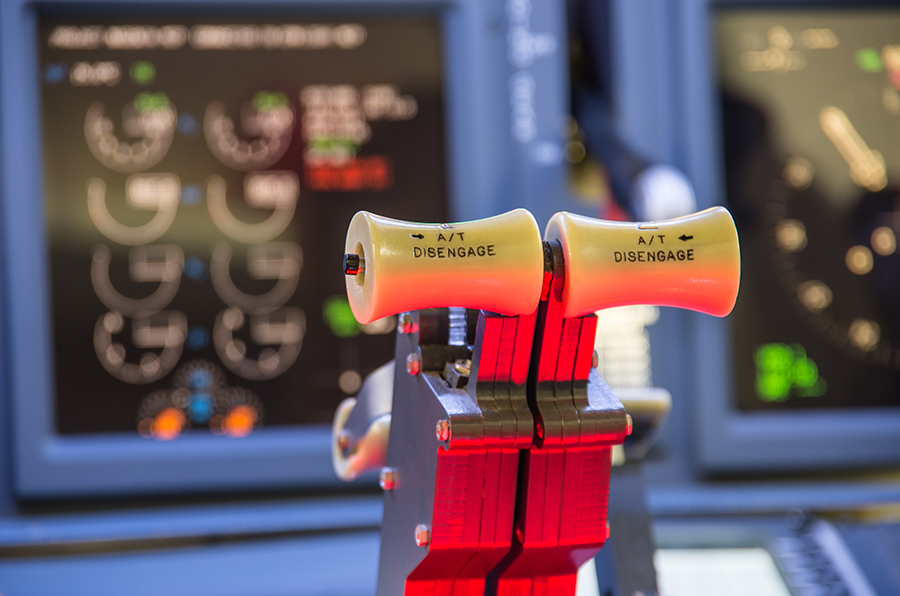-
Why Do We Need Taxiway Lighting?
-
What Types Of Lights Are Used?
-
Taxiway Centerline Lights
-
Taxiway Edge Lights
-
Lights On Curved Taxiways
-
Clearance Bar Lights
-
Runway Guard Lights
-
Stop Bar Lights
-
Taxiway Centerline Lead-Off Lights
-
Taxiway Centerline Lead-On Lights
-
Runway Status Light System
- Runway Entrance Lights
- Takeoff Hold Lights
-
How Do Landing Aircraft Know If The Runway Is Occupied?
-
How Do Pilots Control Airport Lighting?
- Types of PCL
-
Conclusion
If you fly over an airport at night, you’ll see the terminal and apron areas brightly lit with floodlights. The active runway will also be lit up like a Christmas tree. Why is the area between them so dark?
Taxiway lighting is a lot more subdued than runway lighting but is equally intricate in its layout and design.
The contrast between the runway and taxiway lighting is deliberate. You can imagine the consequences of an approaching aircraft mistakenly lining up with a taxiway instead of a runway.
Why Do We Need Taxiway Lighting?
Taxiway lighting helps pilots have a clear idea of where the centerline and the edges of the taxiway are. Taxiway lighting isn’t only useful at night, it’s also helpful during the daytime when the airport is experiencing inclement weather with low visibility.
Terminal areas and aprons are often brightly lit with floodlights, however, pilots are not allowed to maneuver the aircraft freely through the ramp. All ramp areas have designated taxi routes which are designed to maintain clearance between taxiing aircraft and obstacles on the ground.
Many aircraft are so long that their wings are not visible from the cockpit. Keeping the nosewheel on the centerline ensures clearance between parked aircraft and the taxiing aircraft’s wingtips and tail. You’ll also avoid collisions with airport structures such as ramp lights or hanger walls.
Situational awareness is critical even when the aircraft is on the ground. The deadliest aviation disaster of all time did not happen in flight, it happened on the ground in low visibility. A KLM Boeing 747 accelerating on its takeoff run hit another taxiing Boeing 747 in Tenerife, Spain. The resulting collision led to 583 deaths.
The taxiing Pan Am 747 was supposed to exit the runway before the KLM flight took off, but the pilots could not find the taxiway due to extremely low visibility. The KLM pilots had no idea that the runway was still occupied.
While the primary cause of the Tenerife disaster was a miscommunication between the aircraft and Air Traffic Control, recent advances in taxiway lighting are designed to prevent exactly this type of accident by increasing pilot situational awareness.
What Types Of Lights Are Used?
Taxiway lights can be either LEDs or incandescent bulbs. Incandescent lights are usually found at older or small airfields. They’re cheaper to buy than LEDs, but don’t last as long and have higher operational costs.
Airfields in colder regions of the world often prefer incandescent bulbs because they have a neat side effect. Unlike an LED light, an incandescent bulb generates a considerable amount of heat during its normal operation. This heat helps melt snow off of the light and increases its visibility to pilots and ground vehicles.
LED lights to need to have a dedicated heating element, which adds to the operational and electricity costs, plus is yet another part that needs to be maintained.
Taxiway lights can be omnidirectional, bidirectional, or unidirectional depending on their use case. Each type of light also uses a different color to send its intended message. The color usage is roughly aligned with traffic lights on roads.
Green lights indicate a valid route to follow, yellow lights call for caution, and red lights generally ask you to exercise extreme caution or indicate you need to stop. Other colors such as blue and white are used to differentiate between taxiways and runways.
Taxiway Centerline Lights
Centerline lights are the most basic taxiway lights. As is evident from the name, they follow the painted taxiway centerline. These lights are bidirectional. They burn steadily and emit a distinctive green light.
Remember that runways have white centerline lights. Despite the difference in colors, pilots have been known to line up with taxiways for takeoff and landing. This usually results in a pilot deviation report and a stern phone call from the FAA.
Centerline lights are also found in other areas where aircraft move along the ground. Ramps and aprons also have designated taxi routes that are marked with green centerline lights. You’ll also find green centerline lights on taxi routes along some portions of runways.
If you look closely at a taxiway at a time when the lights are lit up but the painted centerline is still visible, you’ll see that the lights are positioned slightly offset from the painted line.
Centerline lights are positioned at an offset from the taxiway’s actual middle by design. The maximum offset allowed from the painted line is 2 feet. The pilot doesn’t need the lights when there’s sufficient ground visibility and will simply steer the aircraft to guide the nosewheel along the painted centerline.
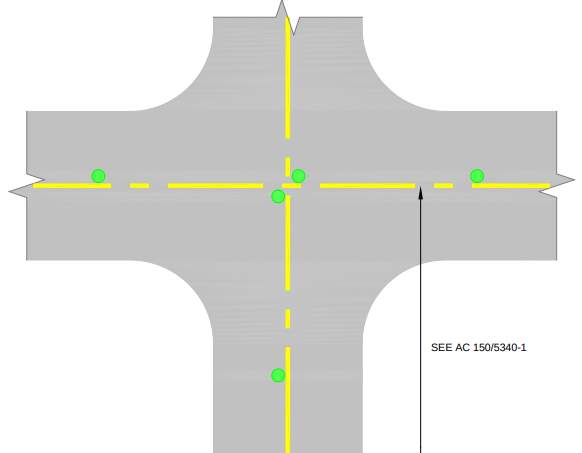
If the lights were placed directly over the painted line, the nosewheel would bump into them repeatedly as the aircraft taxis along. This gets annoying for the pilot and the passengers in the back.
Not all taxiways have their centerline lights offset. You can often find the lights placed right on top of the painted line at smaller airports.
Flight instructors sometimes encourage their students to hit every centerline light as they taxi the aircraft. ‘I want to hear the bumps’ is the expression repeatedly heard by new students who are sloppy in their taxiing. This maneuver familiarizes the student with the position of the aircraft nosewheel in relation to their seating position and is ultimately intended to improve the accuracy of their landings.
While they are designed as inset lights, centerline lights are still raised about an inch off the runway. If your aircraft doesn’t have an oleo strut on the nosewheel, you’ll feel the bump a lot more harshly. Small aircraft with bungee-type steering can also find themselves careening off to the side when a high-speed impact bounces the nosewheel at an angle.
Taxiway Edge Lights
It’s not easy for pilots to discern asphalt from the unprepared soft ground in between taxiways since they both appear black at night. The yellow taxiway edge markings are only visible when they’re being lit up by the aircraft’s lights and can be missed by the pilots even then.
Surface contaminants like water or dust can also obscure edge markings. If the pilot misjudges the taxiway and inadvertently drops one of the wheels off of the pavement, it’ll sink down into the ground and immobilize the aircraft.
Taxiway Edge Lights are placed at regular intervals along the edge markings and are aligned with the lights on the opposing side of the taxiway. The spacing in between the lights is highly regulated by the FAA and can vary from 50 to 200 feet depending on the requirements of the location.
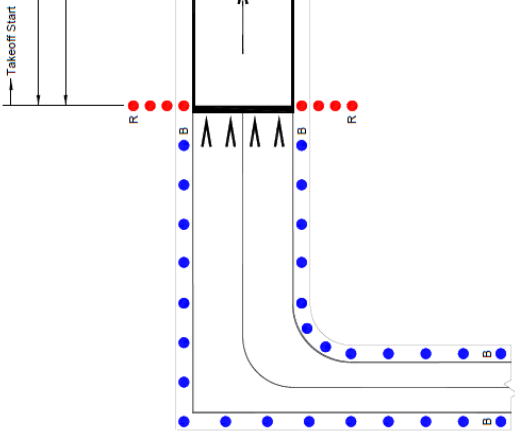
Unlike most airport lighting systems, taxiway edge lights aren’t directional. They emit light in all directions, but their relatively low intensity helps prevent the airport from looking like a chaotic mess of blue light. Any excessive brightness is unnecessary since these lights are only really needed by the aircraft and ground vehicles using the taxiway. They’re practically invisible to aircraft flying overhead.
Edge Lighting is used to highlight apron boundaries too. It may sometimes be classified separately as Apron Edge Lighting, but the lights are exactly the same as Taxiway Edge Lighting.
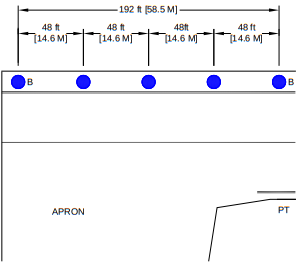
The parts of the apron or taxiway where aircraft need space to maneuver can have the edge lights recessed into the pavement to avoid damage in case a wheel rolls over them.
Jet blasts from the engines can also damage lighting fixtures sticking up from the ground, so recessed edge lights are also allowed in areas such as taxiways crossing behind a runway end.
The FAA also allows reflectors to be used alongside edge lights to make the boundary even more conspicuous. In some cases, reflectors may even be used in place of taxiway edge lighting as long as the centerline is lit well enough. This helps small airfields save on operational costs.
Lights On Curved Taxiways
Pilots need to be acutely aware of the boundaries of the prepared surface when they’re turning the aircraft. Long aircraft can have their main landing gear located at quite a distance from where the pilots are sitting.
The wheels aren’t visible from the cockpit, so the pilots have to visualize their position and their path through the turn. The main landing gear will take a shorter arc than the nosewheel through the turn and can end up clipping the shoulder and burrowing into the ground.
Pilots operating very long aircraft use a technique called Judgemental Oversteering. In this technique, the pilots don’t turn the aircraft when along the centerline through the turn and keep going straight ahead. The pilots only begin the turn when they’re sure that the turning arc of the main landing gear will remain within the inner edge of the curved taxiway.
Newer taxiways are designed to discourage pilots from using this technique. That’s because Judgemental Oversteering is basically the pilot making an estimate or an educated guess of the right time to begin the turn, and there’s a significant chance of a taxiway excursion due to pilot error or inexperience.
Airports solve this problem by offsetting the centerline to the outside of the turn. The pilots are supposed to follow this line precisely and not rely on guesswork anymore. The FAA calls this concept Cockpit-over-Centerline.
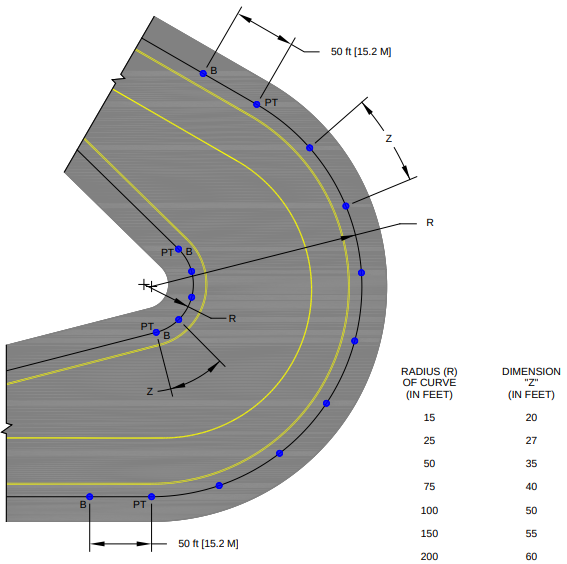
As you can see from the diagram, the spacing between the edge lights on both sides is strictly regulated. The inner side of the curve has the lights bunched up to make the critical inner boundary clearly visible. The centerline is also displaced towards the outer edge of the taxiway.
Clearance Bar Lights
Clearance bars are a row of lights that indicate holding positions on taxiways. These holding positions are different from runway holding points and are mainly used in very low visibility operations.
Clearance bars are also used to warn aircraft and ground vehicles of an approaching taxiway intersection. ATC will often issue taxi instructions that clear the aircraft to taxi but require them to hold short of a particular taxiway to give way to other traffic. The aircraft or ground vehicle is supposed to stop before crossing these lights.
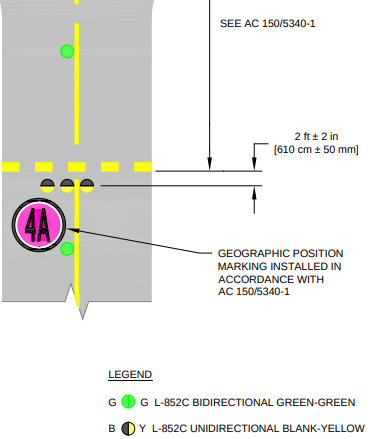
A clearance bar is made up of three steady-burning yellow lights placed perpendicular to the taxiway. These lights have to be in-pavement since aircraft need to taxi over them.
Clearance bars are mandatory for taxi operations when the visibility is lower than 600 feet RVR.
Runway Guard Lights
Runway Guard Lights (RGLs) are similar to Clearance Bar lights, except that they’re placed at a far more critical location. RGLs are placed ahead of runway holding points and warn taxiing vehicles that they are about to enter an active runway.

While they are mandatory in low visibility conditions, RGLs may be used even in clear weather because of the importance of keeping the runway clear.
Runway Guard Lights have two variants. They may either be placed as a row of at least five yellow in-pavement lights or as a pair of elevated flashing yellow lights on either side of the taxiway.
Take care not to confuse RGLs with Clearance Bar lights. RGLs will always have the runway holding position line nearby.
Whenever the runway is not in use, the RGLs will be deactivated to prevent confusing pilots and ground vehicles.
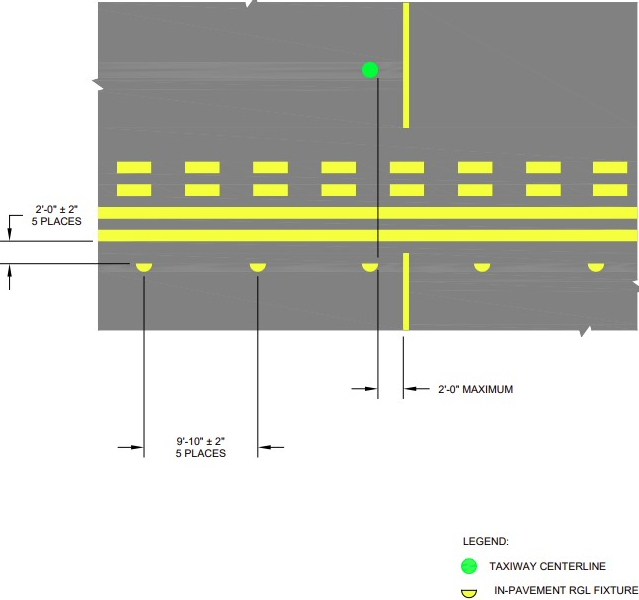
Stop Bar Lights
Stop Bar Lights are a warning signal for an aircraft or vehicle approaching an active runway. Stop bars are a row of unidirectional red lights placed just before the runway holding point markings. They are used to increase situational awareness and serve as an additional visual reminder by ATC that the runway is not to be entered.
Stop bars are placed in-pavement since they cover the entire width of the taxiway and aircraft need to roll over them to get to the runway. If the taxiway is curved or the intersection is at an inconvenient angle, additional raised stop lights can also be installed along both sides of the taxiway so that they are more prominent.
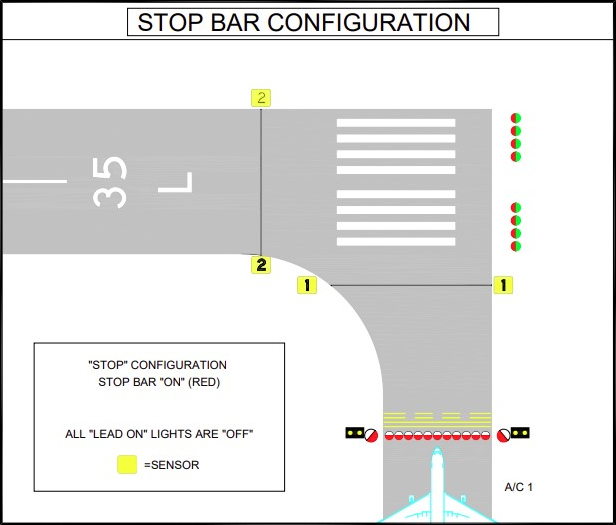
In very low visibility, stop bars also make runway intersections more prominent. Airports that operate below an RVR of 600 feet are required to use stop bars for taxiways leading to active runways.
Stop bars placed on commonly used taxi routes can be individually turned off or on by ATC. These are called controlled stop bars. All other intersections between taxiways and runways have uncontrolled stop bars which work automatically and can’t be operated individually.
Controlled stop bars work in concert with centerline lead-on lights on the runway. As soon as the stop bar turns off, the Lead-On Lights turn on to guide the aircraft for lineup. Sensors placed inside the pavement detect the aircraft’s position and turn the stop bars on again for the following aircraft on the taxiway.
Some airports forego the sensors to reduce costs and use a timer instead. The stop bar and Lead-On Lights reset after a set time period.
Stop bars function as a confirmation of the traffic controller’s guidance. They aren’t meant as a replacement for ATC clearance to enter the runway. If the stop bars extinguish unexpectedly, pilots should hold positions and ask ATC to reconfirm their clearance.
Conversely, if the stop bars don’t go out even after ATC allows the aircraft to enter the runway, don’t move without asking for the stop bars to be extinguished. Pilots should never cross illuminated stop bars.
Taxiway Centerline Lead-Off Lights
Runways have white centerline lights while taxiways have green centerline lights. Aircraft transition between the runway and taxiway with the help of Centerline Lead-Off Lights. These lights alternate between green and yellow and indicate that the aircraft is still within the boundaries of either the runway or the ILS critical area.
Both of these areas need to be vacated as soon as possible since the presence of any aircraft or ground vehicle there poses a danger to other aircraft on approach.
Staying on the runway could lead to the following aircraft having to go around. The worst-case scenario involves the following aircraft spotting the runway incursion too late on its landing roll. In this situation, the trailing aircraft will be too slow to take off again, but too fast to stop in time to avoid a collision.
The radio transmitters of the Instrument Landing System are located at the departure end of the runway. The presence of any aircraft or ground vehicle between the transmitters and an aircraft on an ILS approach could distort or interrupt the guidance signals. These sensitive areas are called ILS critical areas and are kept vacant by ATC when ILS approaches are active.
Taxiway Centerline Lead-On Lights
Similar to Centerline Lead-Off Lights placed on exit taxiways, Centerline Lean-On Lights are installed on entry taxiways. They have the same purpose; to advise the pilot that they’re entering a runway or an ILS critical area so it’s best not to loiter about there. As described previously, Lead-On Lights can be coordinated with Stop Bars to provide complementary visual guidance.
The sensors used for aircraft detection for Stop Bars work with Lead-On lights too. As the aircraft trips the sensor, the Lead-On lights for the previous section of the taxi route switch off to prevent the next aircraft from following it onto the runway.
Lead-On Lights are bidirectional, so the same light fixtures can work as Lead-Off Lights when the runway direction changes.
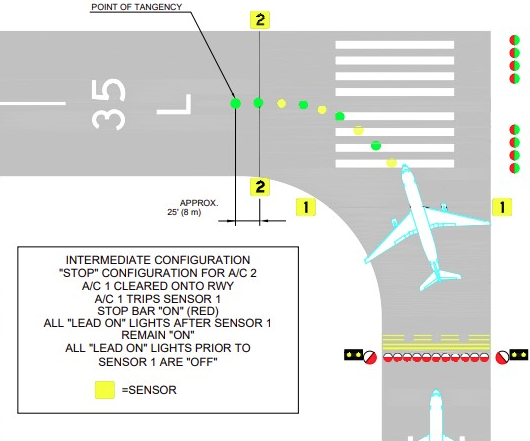
Runway Status Light System
The Runway Status Light System (RWSL) is the newest advisory lighting system being introduced by the FAA. It is fully automated and works completely independent of ATC control.
RWSL has two components; Runway Entrance Lights (RELs) and Takeoff Hold Lights (THL).
Both of these systems use rows of in-pavement red lights that warn pilots and ground vehicles when it is not safe to use the runway. The basic rule of RWSL is that illuminated red lights are not to be crossed.
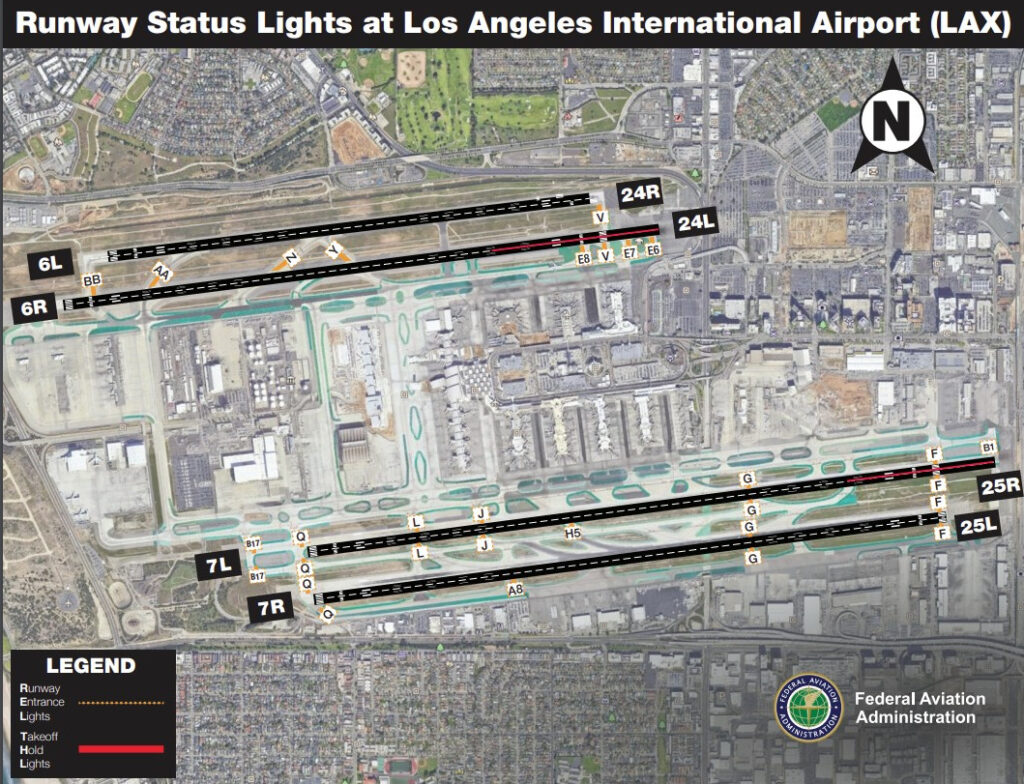
RWSL is currently in use at twenty major airports including JFK, SFO, and ORD, with plans to expand it to smaller airports if it shows promise. The image above shows the taxiways and runways fitted with RWSL at Los Angeles International Airport.
RWSL uses a series of sensors installed within the runway pavement and in intersecting taxiways. These sensors can detect when an aircraft or vehicle passes over them. By combining input from multiple sensors, the system can even detect the speed of the aircraft or vehicle.
How do the sensors detect aircraft?
Vehicles and aircraft are effectively large metal tubes or boxes. If they come close to an existing magnetic field, the metal disrupts the flow of the field. The disturbance is used as an input signal for the system.
The FAA is also introducing other new technologies like ASDE, Airport Surveillance Radar, and Transponder Multilateration to keep track of aircraft moving on the ground. Data from all of these sources are combined to improve accuracy and add redundancy to the system.
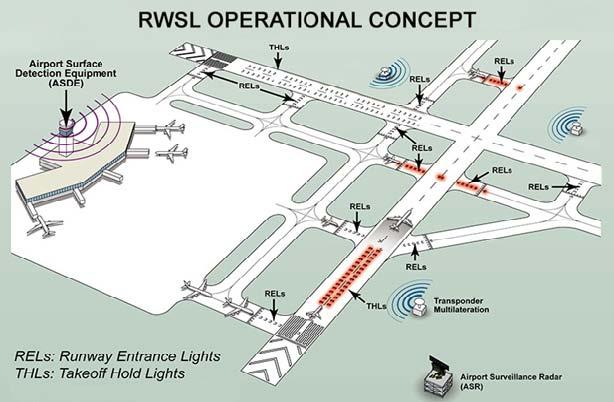
Keep in mind that RWSL only acts as an additional safety system for increasing situational awareness. It doesn’t replace ATC clearances and is just meant as a visual confirmation of a clearance issued by ATC.
Since the lights are unidirectional, most of them won’t even be visible to the tower. The pilots need to reconfirm their clearance in case there’s a mismatch between ATC instructions and the light signals.
Runway Entrance Lights
Runway Entrance Lights (RELs) are parallel rows of in-pavement red lights placed along the taxiway centerline ahead of the runway hold-short lines. One of the lights will always be placed before the line and the rest at equal-spaced intervals till the edge of the runway. The lights are highly directional and can only be seen from the taxiway behind the hold-short line.
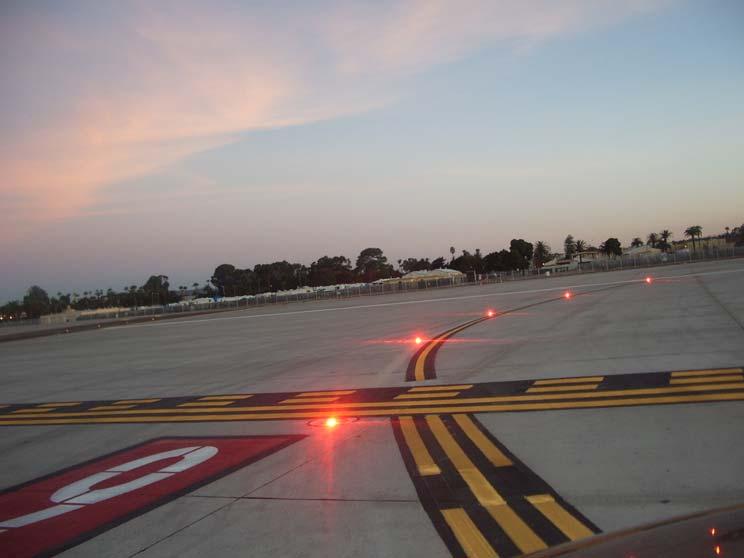
The RELs are activated when the system detects a departing aircraft reaching the speed of 30 knots along the runway. RELs along all intersecting taxiways on that runway immediately light up.
The sensors detect when the departing aircraft is about to cross a taxiway and preemptively extinguish the RELs a couple of seconds before it passes the taxiway. This saves the taxiing aircraft time, allowing it to resume taxiing as soon as possible. When the system determines the departing aircraft is airborne, it switches all of the RELs off.
The REL system can also detect aircraft on approach. RELs on all intersecting taxiways light up when the aircraft comes within one mile of the runway threshold. The system shuts down RELs progressively as the aircraft passes each taxiway. When its speed drops below 85 knots, all the RELs more than 30 seconds ahead of the aircraft shut down.
The system turns off all RELs when the landing aircraft has slowed to 34 knots. The speed thresholds can be adjusted for each runway to work better with the taxiway design.
Pilots should normally already be stopped before the RELs light up. If ATC clears entry onto the runway but the RELs are lit, it’s best to reconfirm your clearance and advise ATC of the lit RELs. A more concerning scenario is if the aircraft has already moved past the runway hold line when the RELs light up.
If the pilots are unable to contact ATC immediately due to frequency congestion, they must use their best judgment to decide whether to hold position or cross the runway if they are already too far beyond the hold line. Any decision to continue onto the runway should be made with the understanding that the runway is not safe to enter.
Takeoff Hold Lights
Takeoff Hold Lights (THLs) are the REL’s counterpart on the runway. They are configured as two parallel rows of red lights and are placed on either side of the runway centerline. THLs are also unidirectional and face the arrival end of the runway. They can be viewed by aircraft coming in for landing as well as those lining up for departure. The lights begin around 375 feet down the runway and continue for up to 1,500 feet.
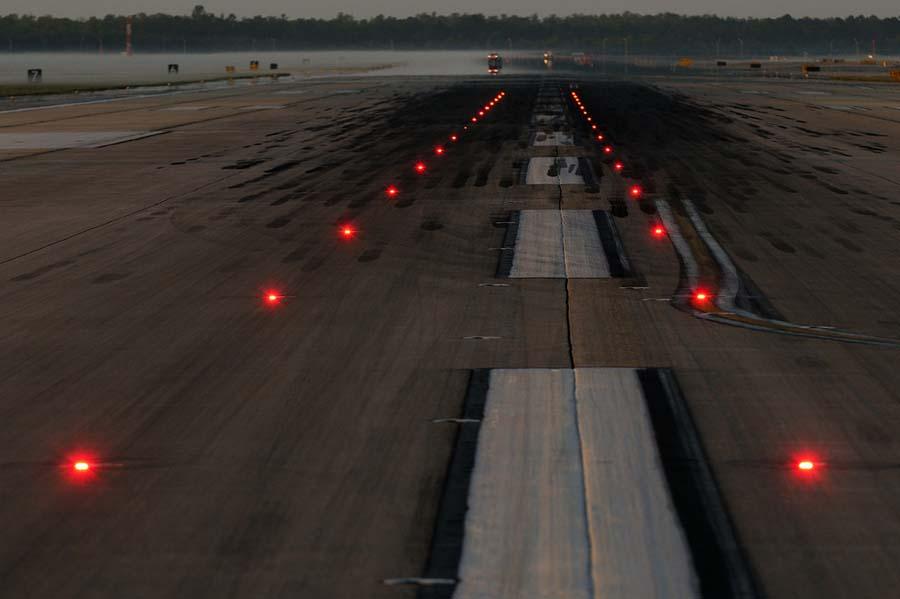
THLs light up when an aircraft or ground vehicle is crossing or is about to cross the runway while an aircraft is lined up for departure or has just started the takeoff run. The lights switch off a few seconds before the runway is cleared, similar to how the RELs work to save time.
The pilots might see the THLs cycle on and off several times if multiple aircraft or vehicles cross the runway. Remember that the THLs switching off does not mean that the aircraft is cleared to takeoff. The takeoff clearance will always be explicitly issued by ATC.
If the pilots commence their takeoff roll and the THLs light up while the aircraft is picking up speed, they should abort their takeoff if they are able to do so. As with the RELs, any unexpected illumination calls for asking ATC for clarification.
If the pilots are unable to contact ATC, they’ll have to use their best judgment to decide if it’s safer to continue rolling or abort the takeoff.
How Do Landing Aircraft Know If The Runway Is Occupied?
The THLs are too dim to be seen by landing aircraft until they’re very close to the runway threshold. The data provided by the RWSL sensors embedded in taxiways and runways is also linked to other safety lighting systems.
The Final Approach Runway Occupancy Signal or FAROS flashes the normally steady burning PAPI lights to warn landing traffic about runway incursions.
If you see the PAPI flashing on and off while on approach, always abort the landing attempt and go around.
How Do Pilots Control Airport Lighting?
Most airport lighting is controlled by ATC, including taxiway lights. Some light assemblies have a built-in photometric sensor that illuminates the light automatically when the atmospheric light decreases at dusk or in bad weather.
Manual control, however, is retained by ATC or the local FSS for uncontrolled airfields. Pilots can request the lights to be turned on even in relatively good visibility and ATC will usually comply.
Lighting is usually available at multiple intensity levels. The highest level is typically used during low visibility conditions in the daytime. Clear nights require the lowest light intensity. If the lights are kept too bright at night, they’ll ruin the pilots’ night vision. It takes twenty to thirty minutes for the eyes to readjust to darkness so if you do get blinded by harsh light, your go-around will be somewhat tricky.
How is the airport lighting controlled at airports that don’t have ATC?
Some airports have their lights operated by an unmanned system that is connected to a radio tuned at a specified frequency. It’s called the PCL, or Pilot Controlled LIghting system. You might also find it referred to as the Aircraft Radio Control of Aerodrome Lighting or ARCAL.
How does the system work if there’s no one to listen on the other end of the radio?
The pilot triggers the lights by keying the aircraft’s microphone when tuned in to the frequency. The system counts the clicks of the microphone and turns the lights on at the pilot’s desired intensity.
The supported runway, lighting types, and the required frequency are mentioned in the FAA’s Chart Supplement U.S for all public airports. Sectional maps won’t have this information, but if any instrument approach procedures exist for the airport, they’ll include the lighting data.
All of the airport lights that support radio activation are tuned to a single frequency. For most airports, that’s usually the associated UNICOM or Common Traffic Advisory Frequency (CTAF). Airports that have part-time ATC use the tower frequency for PCL.
Keying the mic will turn on all the lights including the taxiway lights if they’re connected to the PCL system.
Once activated, the lights operate on a timer and shut down automatically after 15 minutes. The lights flash once when two minutes before the timer expires to warn the pilot that the lights are going off soon.
You wouldn’t want them to extinguish just as you’re on a short final or navigating a tight turn on the taxiway, so it’s best to plan when to start the countdown. Most pilots do it on the base turns or on finals.
The receiver’s sensitivity is also kept low on purpose when there are multiple airfields in the vicinity using the same frequency, so you might have to come in close before the system responds.
If time’s running out, you can reset the countdown by clicking the mic again or changing the light intensity.
Types of PCL
PCL systems have two main types; Type J and Type K.
Type K systems have adjustable light intensity settings. The lights are turned on by clicking the mic seven times within five seconds. After being activated, the light intensity can be set to low, medium, or high by clicking the mic three, five, or seven times respectively.
The FAA’s Aeronautical Information Manual recommends that pilots click the mic seven times initially to illuminate every controllable light at maximum intensity and then readjust to a lower setting that’s appropriate for the conditions.
Type J systems don’t have adjustable light intensity, and only require five clicks to turn on.
The downside of PCL is that it adds to pilot workload during a critical phase of flight, But on the other hand, if it weren’t for the PCL system, lots of small airports wouldn’t even have night operations since they can’t afford to hire ATC personnel or keep the lights on all night.
Small airports usually don’t get enough traffic to support either of the two options above and even some large controlled airports switch to uncontrolled operation at night to save on costs.
Conclusion
Given the high cost of a misunderstanding and the hundreds of lives at stake at each airport, the FAA is continually making improvements to bring more sources of information to pilots, ground crew, and ATC.
Every additional bit of situational awareness helps in reducing collisions on the ground. It is very likely that if systems such as RWSL existed back in 1977, they could have helped avert the Tenerife disaster.



